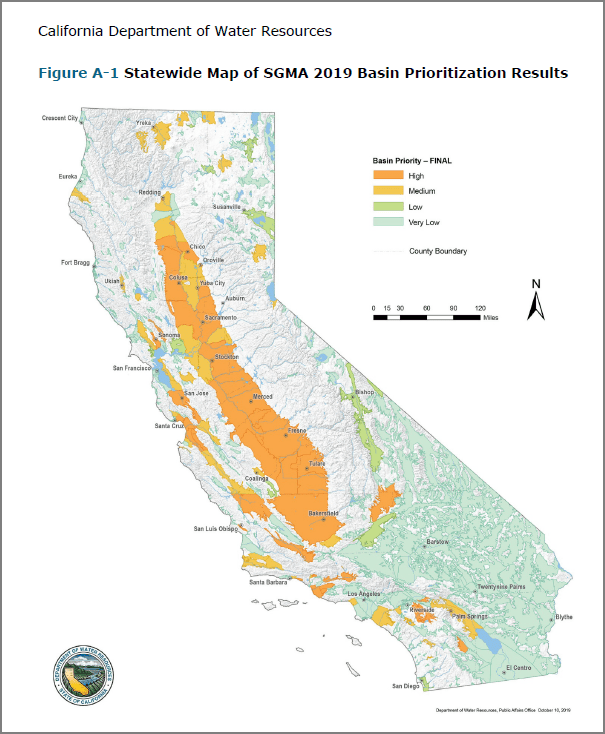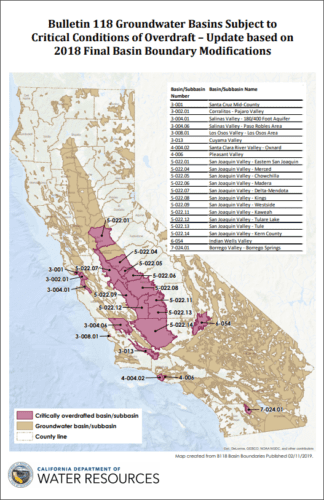Sustainable Groundwater Management Act (SGMA)
From its development in the legislature to local implementation, Downey Brand has been continually involved with the Sustainable Groundwater Management Act (SGMA) of 2014. As this landmark change in California’s water law unfolds, our attorneys remain at the forefront. The materials on this page provide an overview of the law and key information associated with its implementation.
SGMA Overview and Reference Guide
The Sustainable Groundwater Management Act was enacted in 2014 and became effective January 1, 2015. The goal of the legislation is to bring groundwater basins that are designated as medium or high priority basins into sustainability—where inflows (recharge) match outflows (pumping) on a long-term basis and groundwater storage is maintained. The Sustainable Groundwater Management Act will have lasting implications on water users throughout the State. Downey Brand’s water law practice has created a helpful reference guide for professionals in the water industry—A Compendium of California’s Sustainable Groundwater Management Act.
This guide includes the following critical resources in one readily-accessible location:
- The current text of SMGA from SB1168 (Pavley), AB1739 (Dickinson), SB1319 (Pavley), AB 617 (Perea), AB 939 (Salas), SB 562 (Cannella), and SB 2874 (Gaines);
- Basin Boundary Regulations (Cal. Code Regs. tit. 23, § 340-346.6);
- Groundwater Sustainability Plan Regulations (Cal. Code Regs. tit. 23, § 350-358.6); and
- Streamlined Adjudication Statutes (Code of Civ. Proc. § 830-852).
Groundwater Basins Subject to SGMA
In total there are 431 groundwater basins in California. Of those, 24 are subdivided into a total of 108 subbasins, providing a total of 515 distinct groundwater systems. (California’s Groundwater, Bulletin 118, 2003 Update, California Department of Water Resources (October, 2003).)
Each basin and subbasin in California has been prioritized as low, medium, or high priority by the California Department of Water Resources using the following eight criteria: 1. Overlying population; 2. Projected growth of overlying population; 3. Public supply wells; 4. Total wells; 5. Overlying irrigated acreage; 6. Reliance on groundwater as the primary source of water; 7. Impacts on the groundwater; including overdraft, subsidence, saline intrusion, and other water quality degradation; and 8. Any other information determined to be relevant by the Department. This metric provides an indicator of the importance of groundwater as a resource within the basin. If a large and growing population, for example, relies on groundwater for its supply, and the basin is also taxed by significant pumping for irrigated acreage, the groundwater resource is of the utmost importance and the basin will be designated a high priority basin.
Here is a map of the Department of Water Resources’ 2019 prioritization of groundwater basins in California and a report by DWR about its prioritization process (click on the map to view a larger PDF).
DWR has also identified 21 critically over drafted basins (click on the map below to view a larger PDF):
- Santa Cruz Mid-County
- Corralitos – Pajaro Valley
- Salinas Valley -180/400 Foot Aquifer
- Salinas Valley – Paso Robles Area
- Los Osos Valley – Los Osos Area
- Cuyama Valley
- Santa Clara River Valley – Oxnard
- Pleasant Valley
- San Joaquin Valley – Eastern San Joaquin
- San Joaquin Valley – Merced
- San Joaquin Valley – Chowchilla
- San Joaquin Valley – Madera
- San Joaquin Valley – Delta-Mendota
- San Joaquin Valley – Kings
- San Joaquin Valley – Westside
- San Joaquin Valley – Kaweah
- San Joaquin Valley – Tulare Lake
- San Joaquin Valley – Tule
- San Joaquin Valley – Kern County
- Indian Wells Valley
- Borrego Valley – Borrego Springs
Groundwater Sustainability Agencies
To comply with SGMA, certain local agencies may elect to become a groundwater sustainability agency (GSA) with the authority to manage a particular groundwater basin. Water Code, § 10725.2(a). Management will occur pursuant to a groundwater sustainability plan (GSP) or plans that outline how the basin will be managed in the long term.
SGMA requires the formation of GSAs in medium- and high-priority groundwater basins. GSAs must then develop and implement GSPs to achieve groundwater sustainability. Notices that local agencies have submitted to DWR to date are here.
Groundwater Sustainability Plans
Local agencies that elect to become a GSA will be tasked with developing a GSP and identifying and implementing the sustainability goal. Water Code, § 10727. In establishing this goal, GSAs must “consider the interests of all beneficial uses and users of groundwater.” Water Code, § 10723.2. Further, SGMA affords local agencies that elect to become a GSA and that develop a GSP with additional authority and tools to enforce groundwater management in their service areas. See Water Code, § 10725 et seq.; 10730 et seq. For example, SGMA grants GSAs the ability to curtail groundwater pumping; regulate the spacing of groundwater wells; require registration of groundwater facilities; monitor groundwater extractions; and impose standards on new groundwater well construction). If local agencies do not elect to become GSAs, or fail to submit and implement a sufficient GSP, the State of California may assume these powers.
GSPs for critically overdrafted basins were due on January 31, 2020; those for non-critically overdrafted basins are due January 31, 2022. GSPs submitted to date are available here.
For basins with multiple GSAs that will implement multiple GSPs, SGMA requires a coordination agreement to be executed by the GSAs to ensure that the plans utilize the same data and methodologies. Coordination agreements that have been submitted to DWR are available here.
Alternatives
SGMA allows local agencies to submit alternative plans in lieu of a GSP. DWR approved alternative plans in the following basins:
- Niles Cone Subbasin
- Indio Subbasin
- Mission Creek Subbasin
- Pajaro Valley Subbasin
- Santa Clara Subbasin
- Llagas Area Subbasin
- Tahoe South Subbasin
- Coastal Plain of Orange County Basin
- Livermore Valley Basin
A list of alternative plans submitted is available here and DWR’s evaluation of the alternative plans is available here.
Streamlined Adjudications
There are currently 22 adjudicated basins in California, mostly in Southern California. The Scott River system, near the Oregon border, was adjudicated to help resolve a surface water controversy. The Seaside Basin, near the Monterey Peninsula, was adjudicated after annual pumping was in excess of safe yield and posed a risk for seawater intrusion. The remaining adjudications have all been in Southern California, where development pressures quickly overwhelmed limited aquifers. The remaining adjudicated basins are: Beaumont Basin (2004), Brite Basin (1970), Central Basin (1965), Chino Basin (1978), Cucamonga Basin (1978), Cummings Basin (1972), Goleta Basin (1989), Main San Gabriel Basin: Puente Narrows (1973), Mojave Basin Area (1996),
A year after SGMA was enacted, the legislature enacted a new set of procedures for streamlining groundwater adjudications. One streamlined adjudication has been initiated in California in the Los Posas Basin in Ventura County. The case is currently pending in the Superior Court for the County of Santa Barbara.
David R. E. Aladjem
David R. E. Aladjem
Retired

David Aladjem helps clients throughout California manage and resolve water resources management problems, especially those at the intersection of water rights, endangered species, and CEQA/NEPA.
Sacramento 916.520.5361
Retired
Sacramento 916.520.5361
Rebecca R. A. Smith
Partner
Sacramento 916.520.5281
Announcements
3 related itemsIn the News
1 related items-
October 19, 2018California Leans Heavily on its Groundwater, But Will a Court Decision Tip the Scales Against More Pumping?
Western Water
Speaking Engagements / Events
20 related items-
February 24, 2024Water Rights Enforcement in California
2024 California Water Law Symposium - 1913 to Now: Diversifying Solutions to Water Governance in California -
December 1, 2023SGMA and Groundwater Comprehensive Update: Basin Boundaries, Sustainability Agencies and Plans, and Streamlined Adjudications
County Counsels' Association of California Fall 2023 Land Use Study Section Meeting -
November 30 - December 1County Counsels’ Association of California Fall 2023 Land Use Study Section Meeting
Embassy Suites by Hilton Monterey Bay Seaside, California -
June 8-9. 2023California Water Law, Policy, and Management in This Time of Extremes
Argent Communications 37th Annual California Water Law & Policy Conference -
February 4, 2023Conflicting Interests Between Agriculture & Species Conservation
2023 California Water Law Symposium - Diverse Needs: Species Protection & Water Supply -
August 9-11, 2022Waves of Change: Water Resource Management and Infrastructure at the Turning Point
Speaker, National Association of Flood & Stormwater Management Agencies' Annual Meeting -
April 21, 2022Waterside Chat
Panelist, Center for Land-Based Learning Event -
April 19 & 21, 2021Water Rights, Policy, Regulation, and the Future under the New Administration
Argent Communications 35th Annual California Water Law & Policy Virtual Conference -
January 30, 2021Innovations in Water Storage As A Response To Climate Change
2021 California Water Law Symposium, Climate Change: Adapting to a Warming Climate -
April 22, 2020Sustainable Groundwater Management Act
Co-instructor, UC Davis Extension -
February 20, 2020Legal and Institutional Management Framework
Presenter, Water Education Foundation Water 101 Workshop -
July 25-26, 2019SMGA and Groundwater Adjudications
Presenter, LSI Conference on Sustainable Groundwater Planning in California -
June 20-21, 2019Developments in Water Supply Regulation, Reporting, and Legislation
Argent Communications 34th Annual California Water Law & Policy Conference -
May 2-3, 2019County Administration of Groundwater Under CEQA, the Public Trust Doctrine and SGMA – ELF v. SWRCB and POWER v. Stanislaus County
Co-presenter, County Counsels' Association of California Spring 2019 Land Use Conference -
February 2, 2019Questions of Common Supply: SGMA Requirements for Interconnected Surface Water and Groundwater
Moderator, 2019 California Water Law Symposium - California Groundwater: SGMA & Beyond -
November 14, 2018Can California Successfully Integrate Groundwater and Surface Water Under SGMA?
Presenter, Groundwater Resources Association, Sacramento Branch Meeting -
May 10, 2018Water Transfer and SGMA
Moderator, ACWA 2018 Spring Conference & Exhibition -
January 20, 2018Utilization of Water Transfers to Recharge Groundwater Basins
Moderator, 14th Annual California Water Law Symposium -
October 3, 2017Groundwater Rights: Management, Regulation, and Exercise
Presenter, HalfMoon Education Seminar on California Water Laws, Regulations and Recent Developments -
November 8, 2016Preparing for Sustainable Groundwater Management: Recharging Groundwater from a Water Rights Perspective
Presenter, CalCIMA 2016 Education Conference
Legal Alerts
1 related items-
November 20, 2023Court of Appeal Upholds County of Monterey’s Management of Groundwater in Landmark SGMA Case
Water Law
Publications
10 related items-
June 2023California Department of Water Resources Approves 12 Groundwater Sustainability Plans for Non-Critically Overdrafted Basins
Environmental, Energy & Climate Change Law and Regulation Reporter, Volume 3, Number 9 -
September 2022California Assembly Bill Would Require Groundwater Sustainability Agency Involvement in Local Agency Well Approval Process
California Water Law & Policy Reporter, Volume 32, Number 11 -
March 2022DWR Deems Groundwater Sustainability Plans for 12 Critically Overdrafted Basins Incomplete and Require Revision
California Water Law & Policy Reporter, Volume 32, Number 6 -
September 24, 2018Appellate Ruling Extends Public Trust Doctrine to Groundwater
The Daily Transcript -
July 2018Adjudicating Groundwater: A Judge’s Guide to Understanding Groundwater and Modeling
The National Judicial College, Dividing the Waters -
March 2017Preparing for Sustainable Groundwater Management: A Review of Groundwater Recharge
California Water Law & Policy Reporter, Volume 27, Number 6 -
December 2016A Compendium of California’s Sustainable Groundwater Management Act
Provided by Downey Brand's Water Law Practice -
Fall 2015Marketing the Sustainable Groundwater Management Act: Applying Economics to Solve California’s Groundwater Problems
ABA Natural Resources & Environment, Vol. 30, No. 2 -
January 6, 2015AB 1739; SB 1168, 1319: Groundwater Management
New Laws - Supplement to Daily Journal -
September 29, 2014A Brave New World of Water Regulation
San Francisco Daily Journal












